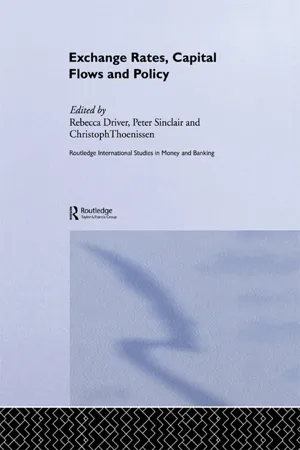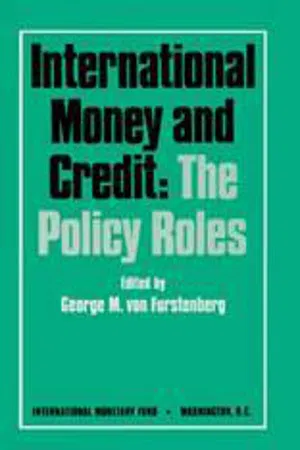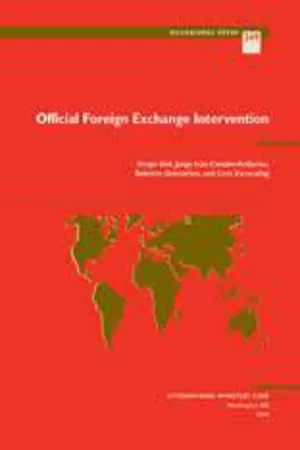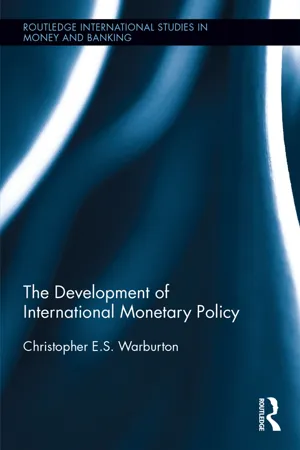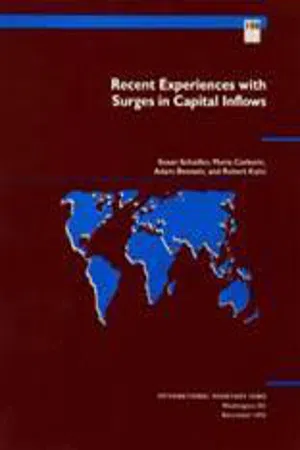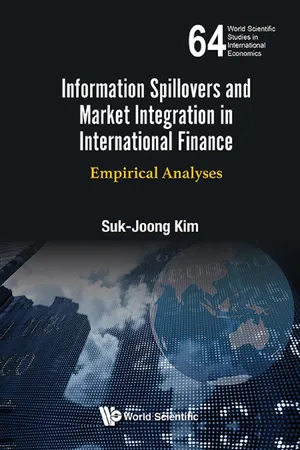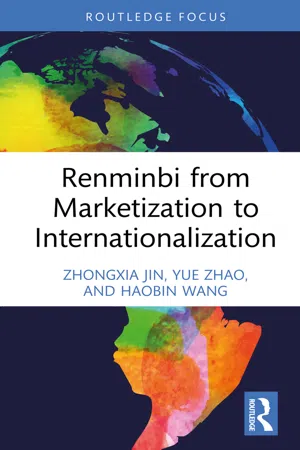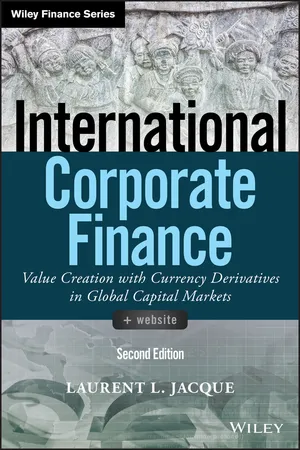Economics
Sterilized Intervention
Sterilized intervention refers to a central bank's simultaneous purchase or sale of foreign currency to influence exchange rates, while also engaging in offsetting domestic open market operations to neutralize the impact on the money supply. This allows the central bank to intervene in the foreign exchange market without affecting domestic monetary conditions.
Written by Perlego with AI-assistance
Related key terms
10 Key excerpts on "Sterilized Intervention"
- eBook - ePub
Money, Banking, and Financial Markets
A Modern Introduction to Macroeconomics
- Dale K. Cline, Sandeep Mazumder(Authors)
- 2022(Publication Date)
- Routledge(Publisher)
The term ‘currency sterilization’ refers to the practice of intervening in the foreign exchange markets with the intention of maintaining the value of one currency relative to another, while also attempting to curb growth in the monetary base. Remember from the foreign exchange market diagram developed in the previous chapter that a country cannot change its interest rate without expecting a resulting exchange rate change. Yet, a country that is fixing their exchange rate would like to get hold of as many foreign assets as possible in order to maintain their fixed exchange rate. Sterilization allows them to do this.Typically, intervention takes place when a central bank purchases foreign currency from its commercial bank system, paying for it by issuing new reserves, resulting in an increase in the domestic monetary base. If that central bank wishes to reverse that injection of new base money (i.e. addition to reserves), it must then employ tactics to adjust out the newly issued reserves, thereby sterilizing the change created by the intervention. Let us now see this process a little more precisely by means of an example.Suppose the Chinese central bank has the following simple balance sheet:Assets Liabilities Domestic Assets 4 trillion Currency 2 trillion Reserves 2 trillion where the vast majority of domestic assets held by the central bank are domestic bonds. Notice that the liabilities side—currency plus reserves—is equivalent to the monetary base. Next, suppose there is increasing pressure on China’s currency, such that it would appreciate if the central bank did not intervene. For example, this could be caused by a greater supply of foreign currencies—such as the U.S. dollar—on the market. The issue for China—the country trying to maintain its exchange rate—is that if these foreign currencies are not removed through intervention, they are available for trade on the foreign exchange market. This enlarged pool of foreign currencies makes the yuan more valuable relative to them, which is not what China desires since it raises the prices of their goods that are exported overseas. This thereby makes Chinese goods less competitive, which is the very thing they wish to avoid. - eBook - ePub
- Rebecca Driver, Peter J N Sinclair, Christoph Thoenissen(Authors)
- 2013(Publication Date)
- Routledge(Publisher)
3If sterilization of intervention is feasible to some extent, it would be desirable whenever the prices of domestic assets need to be insulated from transitory shocks to portfolio preferences perhaps due to domestic nominal shocks such as an exogenous decrease in money supply by the central bank or external financial shocks such as a fall in the world interest rate. Sterilization would also be beneficial if the central bank seeks to accommodate gradually a permanent shift in portfolio preferences into domestic assets from foreign assets in response to market reforms or a decrease in the attractiveness of assets abroad. By contrast, domestic real shocks, such as productivity shocks, exogenous export boom, and exogenous increase in domestic spending, do not call for Sterilized Intervention because the asset price adjustments caused by such shocks are likely to be stabilizing without impairing international competitiveness. In the case of the increase in demand for money, on the other hand, it is better not to sterilize but rather to accommodate the money that private agents want to hold. Such accommodations are not likely to endanger price stability. In general, a program of stabilization and liberalization might cause investors to increase their demand for both domestic money and domestic bonds, and then the capital inflow should be partially sterilized by supplying both assets for which they are desired.4Furthermore, sterilization may carry high “quasi-fiscal costs” which stem from interest rate differentials between government or central bank bonds and foreign exchange reserve assets. This is particularly true for the government of which claimed intentions not to devalue or default on debts are not fully credible on the basis of “permanent money,” resulting in high domestic interest rates which reflect expected inflation or depreciation in the future (Calvo 1991; Calvo et al . 1993; Frankel and Okongwu 1996; Kletzer and Spiegel 1996). The extent of quasi-fiscal costs may play an important role in determining the degree of sterilization or the timing of the abandonment of a sterilization program since bond-financed sterilization may not be sustainable in the long run.5 - INTERNATIONAL MONETARY FUND(Author)
- 1984(Publication Date)
- INTERNATIONAL MONETARY FUND(Publisher)
b declines, thereby producing a negative risk premium. The question of the effectiveness of the interventions then simply boils down to the question of the degree of substitutability between A- and B-bonds. With high substitutability, the size of the sales of B-bonds and purchases of A-bonds will have to be large. In the limit of perfect substitution, no finite amounts will suffice to change the risk premium. In that case, Sterilized Intervention by the two countries becomes completely ineffective.Does it matter which central bank intervenes, when the intervention is sterilized? What is obtained here is an answer similar to the one obtained for the nonSterilized Intervention. If the pure intervention is symmetrical (both countries’ money stocks are unaffected), it does not matter whether country A or B intervenes. In both cases, the money stock is pegged, and the risk premium (—II) will be the same.13 Thus, the conclusion is the same as when the two authorities abstain from sterilization.This conclusion will be different if we assume asymmetry in sterilization behavior. If a country does not sterilize the domestic monetary effects of the other country’s intervention, the question of who does the intervention becomes important again. The analysis here is the same as in the previous section. This leads to a general proposition: It does not matter which central bank intervenes in the exchange market if the institutional arrangements are symmetric—that is, if both central banks abstain from sterilization or if both central banks fully sterilize. However, if the arrangements are asymmetric, it makes a difference who intervenes in the foreign exchange market.This section can be summarized as follows. Intervention policies in the foreign exchange market by one country have quite different effects, depending on the way the other country whose currency is bought or sold conducts its monetary policies. This is true when a country engages in sterilized or nonSterilized Intervention. It has also been emphasized that the degree of substitution between domestic and foreign bonds is important for the effectiveness of (pure) intervention policies. The discussion in this section, however, also stresses that for a given degree of substitution, a particular intervention policy followed by one country will be more or less effective, depending on such institutional arrangements as the form in which international reserves are held or the extent to which countries sterilize the interventions of other countries. It is clear that cooperative arrangements can be found that enhance the effectiveness of foreign exchange market interventions. In general, nonSterilized Interventions will be more effective if they are symmetrical. Sterilized Interventions, however, are more effective if they are asymmetrical.- eBook - ePub
- Jorge Canales Kriljenko, Cem Karacadag, Roberto Guimarães, and Shogo Ishii(Authors)
- 2006(Publication Date)
- INTERNATIONAL MONETARY FUND(Publisher)
The focus in this chapter is primarily on intervention under flexible exchange rate regimes. Under more rigid exchange rate arrangements, including various forms of pegs, central banks have little discretion over intervention policies. Official foreign currency sales and purchases automatically bridge the gap between supply and demand to ensure equilibrium at the predetermined exchange rate. The policy trade-offs and operational issues discussed here apply mainly to countries with independently floating or managed floating exchange rate regimes in which the monetary policy framework is not anchored by an exchange rate target.Intervention can be defined as official purchases and sales of foreign exchange to achieve one or more of the following four objectives: (i) to moderate exchange rate fluctuations and correct misalignment, (ii) to address disorderly market conditions,1 (iii) to accumulate foreign exchange reserves, and (iv) to supply foreign exchange to the market. The aim is to capture what are known to be widely adopted policy objectives of foreign exchange operations in many developing countries to which the best practices advocated here are primarily intended to apply.Following the convention in the literature, the definition of intervention in this paper is narrowed to …sterilized” intervention that does not affect domestic monetary conditions (base money or short-term interest rates). To the extent that a foreign exchange operation is not, or is only partially, sterilized, then the component that is left …unsterilized” is equivalent to a monetary policy operation.2Passage contains an image
How Can Intervention Be Effective?
Exchange rates are supposed to reflect basic supply and demand conditions, which in turn should be linked to underlying macroeconomic fundamentals. The literature provides favorable evidence on the relationship between exchange rates and fundamentals in the long term in economies with full capital mobility (Sarno and Taylor, 2002 ). The parity conditions also hold in developing economies with partial capital mobility (Tanner, 1998 - eBook - ePub
- Christopher Warburton(Author)
- 2017(Publication Date)
- Routledge(Publisher)
Table 7.2 . The sample sizes have variations because of the varying number of willing respondents. The number of respondents is much smaller for Asia, relative to Latin America. Based on daily foreign exchange market turnover, two central banks in Emerging Europe intervened more aggressively. However, from 2007 to 2012, the size of interventions seems to be generally irregular.The size of intervention relative to FX market turnover is symptomatic of a central banks’ market power to affect the current exchange rate, and its share in FX reserves as a measure of their potential strength to influence the future exchange rate. As a group, the Emerging Economies seem to have some amount of market power though their collective strength declined after 2007. The Banks of Korea, Poland, and India intervened to stabilise their currencies after the 2007 crisis (Mohanty and Berger 2013: 61–2).Beyond the stabilisation of fixed exchange rates, sterilised interventions (those dealing with disruptive capital flows) are designed to attain external stability rather than domestic or internal stability. Central banks may purchase and sell foreign currencies in a manner that is not intended to alter the domestic monetary conditions, base money supply (money as a medium of exchange and store of value), and implicitly, the short-term interest rate.The manipulation of the value of a currency falls within a broader spectrum of politics, economics, and law. Implicitly, by the connotation of verbiage, the practice of manipulation is designed to gain undue competitive advantage, which may or may not be disruptive. Since the effects of manipulation have implications for fair international trade, one might reasonably presume that the World Trade Organization (WTO) should have authoritative rights to adjudicate the effects of unwarranted currency valuation. Apparently, exchange rates and trade issues are curiously considered to be separate issues for specialised administration. The IMF is responsible for investigating and making a determination that the value of a currency has been manipulated while the WTO is limited to trade issues. This curious anomaly has made it impractical to resolve exchange rate disputes satisfactorily. - Robert Kahn, Adam Bennett, María Carkovic S., and Susan Schadler(Authors)
- 1993(Publication Date)
- INTERNATIONAL MONETARY FUND(Publisher)
Sterilization
Sterilization was the first line of defense against the surge in inflows, regardless of its cause, in each of the countries. Sterilizing was attractive because it could be implemented quickly and bought time to consider the likely causes and persistence of inflows and to formulate a longer-term response. It sought to curb the monetary effect of the inflows and tended to lock in a cushion of reserves against a possible reversal. As inflows persisted most governments eased the degree of sterilization.Narrowly defined, sterilization is the exchange of bonds rather than money for foreign exchange. In fact, open-market operations were only one of the mechanisms that central banks employed to limit the influence of capital inflows on money. Increases in reserve requirements on all or selected parts of bank deposits, often designed to lengthen the maturity structure of deposits and discourage foreign inflows to the banking system, were also important. Other sterilization-type policies included various forms of central bank borrowing from commercial banks; the shifting of government deposits from commercial banks to the central bank; raising interest rates on central bank assets and liabilities; curtailing access to rediscount facilities; and, in Spain, direct credit controls. Sterilization was also accomplished through sales of government liabilities: this was important in Egypt, where the Government sold bonds to reduce money creation from deficit financing. To capture the bulk of these mechanisms, a broad measure of sterilization is required—namely, changes in the domestic assets of the central bank net of liabilities to the public sector and banks—that is, the domestic counterpart of currency issue.Another difficulty in identifying sterilization is determining causality—whether the reduction in net domestic assets caused subsequent capital inflows or offset previous inflows. In fact, for most of the countries both lines of causality were undoubtedly at play. Except in extreme circumstances—when interest rates are invariant to the supply of bonds or to banks’ free reserves, or inflows are insensitive to interest rate differentials—sterilization will, at least to some degree, increase inflows. Nevertheless, estimates, reported in Appendix I, of the offset coefficient, that is, the degree to which sterilization induces offsetting capital inflows, suggest that, at least historically, the countries under review, with the possible exception of Thailand, had scope for effective sterilization. It must be remembered, however, that for all of these countries domestic financial markets have become increasingly integrated with foreign markets and estimates of offset coefficients using historical data probably underestimate the mobility of capital.- eBook - ePub
Strained Relations
US Foreign-Exchange Operations and Monetary Policy in the Twentieth Century
- Michael D. Bordo, Owen F. Humpage, Anna J. Schwartz(Authors)
- 2015(Publication Date)
- University of Chicago Press(Publisher)
Japan participated, buying nearly $1.7 billion, but Germany remained out of the market. At the 15 November 1994 FOMC meeting, Federal Reserve Bank of Richmond President Broaddus argued against intervention because it must interfere with the Federal Reserve’s monetary-policy independence: As you said, Mr. Chairman, it is now widely agreed that Sterilized Intervention doesn’t have any sustained impact on exchange rates unless it sends a signal that we are going to follow it up with a monetary policy action. This implies, for me at least, and this is really the heart of the matter, that it is not really possible for the Fed to maintain a truly independent monetary policy for an extended period of time while following the Treasury’s lead on foreign exchange policy. Now, of course, in reality the way I see this is that we have maintained our independence by not making a commitment to follow interventions with monetary policy actions. But that’s not a perfect situation either. (FOMC Transcripts, 15 November 1994, 49) In 1995, the Federal Reserve Bank of Richmond articulated the case against intervention (Broaddus and Goodfriend 1996). 46 Although most of the core arguments were well known to FOMC participants, Richmond’s perspective seemed fresh because the authors developed the exposition more completely and clearly than heretofore had been the case. They focused on the connection between intervention and monetary-policy credibility. Sterilized Intervention and the institutions associated with intervention damaged the Federal Reserve’s credibility with respect to price stability, they claimed, because Congress had never statutorily mandated price stability as the Fed’s sole—or even chief—policy goal. The central bank’s credibility with respect to price stability was purely reputation-based. Such credibility is hard to acquire and is inherently fragile - eBook - ePub
Information Spillovers and Market Integration in International Finance
Empirical Analyses
- Suk-Joong Kim(Author)
- 2017(Publication Date)
- WSPC(Publisher)
1 The BOJ explains in a document on its website (www.boj.or.jp/en/about/basic/etc/faqkainy.htm) that any Yen funds to be sold on foreign exchange markets are raised by issuing Financing Bills. So it appears that it is sterilizing its interventions. However in numerous official statements, it claims that it aims to ensure domestic liquidity is optimal, and these interventions may be used to help achieve that.2 This is also referred to as order flow in the literature, and detailed discussion on this issue can be found in Evans and Lyons (2002) and Bacchetta and Wincoop (2003).3 This is known as the “hot potato” syndrome (for example, see Lyons, 2001). It occurs when dealers sequentially unload unwanted positions, until eventually a satisfied counterparty is found.4 Admati and Pfleiderer (1988) suggested another possible reason for trading volumes to be informative — transaction costs. However these are surely very low in the Yen/USD foreign exchange market.5 In a survey of 13 OECD central banks, Lecourt and Raymond (2003) reported that 80% of central banks prefer to deal with major banks, thus ensuring high liquidity and visibility. Sometimes they do trade with brokers, to maintain their anonymity, if their interventions might be interpreted as inconsistent with current monetary policy and thus falsely signal a change. Some central banks, such as the Swiss National Bank, always choose to announce their intervention activities. For the rationales of secret and announced interventions, and corresponding empirical evidence, see inter alia Neely (2001), Dominguez (1998), Kim et al. , (2000), and Beine and Bernal (2004).6 - Zhongxia Jin, Yue Zhao, Haobin Wang(Authors)
- 2022(Publication Date)
- Routledge(Publisher)
FXI can generate macroeconomic impact via many channels. FXI that is not fully sterilized entails a change in monetary stance and can subsequently affect exchange rate and domestic prices. FXI aimed at countering depreciation pressure, for instance, consists of selling foreign currencies and buying domestic currencies, which can be considered a reduction in the central bank’s balance sheet. Without complete sterilization, the reduced balance sheet will result in a tightening of the money supply, contributing to deflationary pressure through falling general prices, rising real interest rates, and potentially falling asset prices.Even with complete sterilization, FXI may still generate macroeconomic impact. The literature on the transmission mechanism of sterilized FXI is vast and rich, and most notably includes works on the portfolio balance channel. The portfolio balance channel (Henderson and Rogoff, 1982 ; Kouri, 1982 ; Branson and Henderson, 1985 ) is predicated primarily on imperfect substitutability between domestic and foreign assets so that any changes in asset composition could affect risk premia. Recent works have advanced the portfolio balance theory using micro-founded frameworks to model the underlying financial friction (Gabaix and Maggiori, 2015 ; Chang and Velasco, 2017; Cavallino, 2019 ; Fanelli and Straub, 2020 ). Sterilized FXI may also generate macroeconomic impact via the signaling channel by revealing the central bank’s policy intentions, thereby influencing market expectations.12Direct Costs of FXI
The empirical results presented herein suggest that while interveners experience less nominal exchange rate volatility in response to external shocks, they bear the consequence of additional adjustments in domestic general and asset prices. Such macroeconomic consequences can be costly but may be overlooked or underestimated as they may not be directly observable.FXI can also incur more direct costs, including the buildup of external imbalances, loss of foreign reserves, suppression of external investment returns, underdevelopment of the foreign exchange market, and conflicting goals between monetary policy and exchange rate policy, which we will briefly discuss next.FXI may impede timely adjustments of the balance of payments in response to negative external shocks. FXI that attempts to counter depreciation pressure can slow the adjustments of the balance of payments. The IMF’s External Balance Assessment (EBA) conducted an empirical analysis and found that FXI results in a buildup of external imbalances, especially in countries with capital account restrictions (Phillips et al., 2013 ).13- eBook - ePub
International Corporate Finance
Value Creation with Currency Derivatives in Global Capital Markets
- Laurent L. Jacque(Author)
- 2019(Publication Date)
- Wiley(Publisher)
ex post basis from variations in the level of central banks' foreign exchange reserves.- In a system of stabilized exchange rates, the central bank is contractually committed to maintaining the prevailing exchange rate within a narrow, publicly defined band of fluctuations. Clearly, uncertainty about future spot exchange rates is, barring a major devaluation or revaluation, the reason this system is often referred to as a system of “pegged yet adjustable” exchange rates, bounded from the standpoint of market participants.
- Under a system of controlled exchange rates, the central bank supersedes the marketplace by becoming the sole buyer and seller of foreign exchange. The rate at which transactions take place is no longer determined by the interaction of supply and demand forces; rather, it is the end product of bureaucratic decisions. Furthermore, buying and selling rates are not necessarily identical, nor are selling and buying rates uniform across all foreign exchange earnings or payments-generating transactions.
QUESTIONS FOR DISCUSSION
- What is the difference between a “clean” float and a “dirty” float?
- Why do countries intervene in their foreign exchange markets?
- What is the difference between currency convertibility and exchange rate flexibility?
- Explain how central bank intervention allows a country to keep its forex rate at a certain level.
- What is the difference between central bank intervention in the foreign exchange market in the context of floating versus stabilized exchange rates?
- How would you contrast a controlled exchange rate with a stabilized exchange rate?
- What does the explosive growth in China's reserves tell you about the nature of its exchange rate regime?
- The last time the U.S. Federal Reserve Bank intervened in the forex market was in 1995. Would you expect the U.S. foreign exchange reserves to have increased or decreased over the past 18 years?
Index pages curate the most relevant extracts from our library of academic textbooks. They’ve been created using an in-house natural language model (NLM), each adding context and meaning to key research topics.

